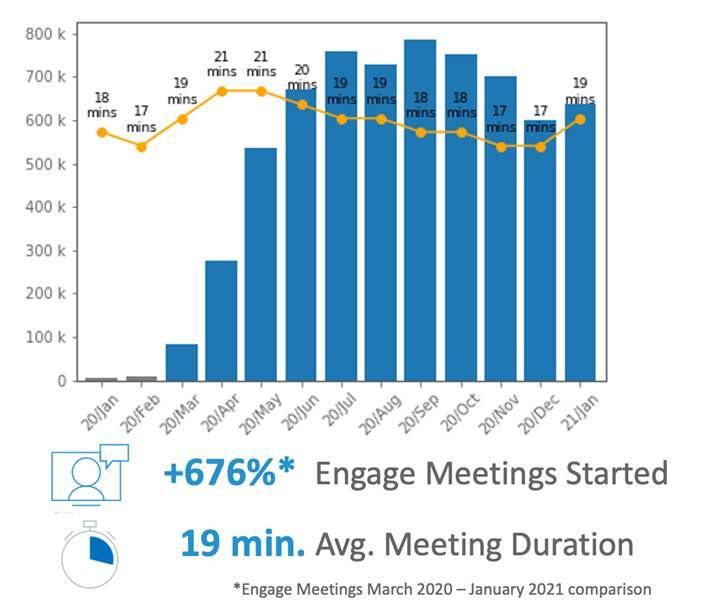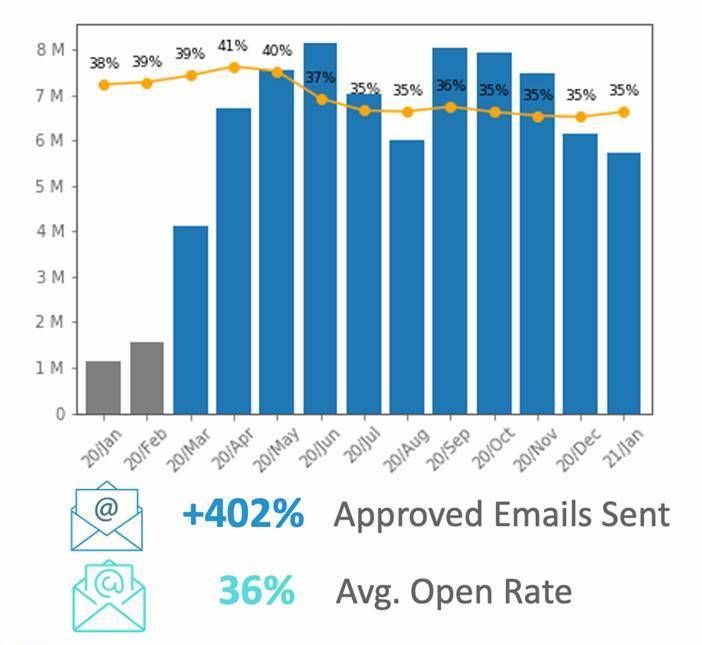Digital is reinventing the critical role of the rep
Covid-19 reveals how important field reps will be to driving digital adoption
Every pharmaceutical company rapidly shifted to digital over the past year so their field teams could stay connected with doctors during the pandemic. From virtual meetings to email, digital has dramatically altered the face of engagement and delivered promising results for sales rep productivity and the healthcare professional (HCP) experience. Doctors have more convenient, efficient ways to interact with reps, while the field has new channels to complement face-to-face visits.
The most dramatic digital shift has been the use of remote meetings as a primary way to engage HCPs. The number of virtual meetings increased more than sixfold, while rep-sent emails rose nearly fivefold, according to the tens of thousands of field rep activities that were captured in Veeva CRM since January 2020.1
The trend toward digital will only accelerate, as companies look at long-term opportunities to rethink commercial operations and find digital ways to better serve doctors. Working with leaders across the life sciences industry, it’s clear that remote selling is here to stay, even when in-person access with physicians and hospitals opens up again, making the role of the rep more important than ever.
Now the question is how do companies navigate this new environment and drive digital excellence in commercial? Success in this new hybrid world will depend on organizations’ rapid move to a modular content approach, leveraging data and insights to optimize digital engagement, and reps having greater flexibility to meet customers on their terms.
Accelerate digital-first engagement with more content, faster
One of the biggest trends we’ve seen in our industrywide Veeva Pulse data has been the increase in average duration of sales calls during Covid-19. Virtual meetings extended the amount of time HCPs were able to meet with reps to 19 minutes, compared to traditional, face-to-face meetings that typically average three minutes.
Source: Veeva Pulse Data, January 2021

Rep-sent emails also saw significant engagement, with an average open rate of 36%, in contrast to the 3% average open rate of headquarter-sent emails. These Pulse trends highlight the vital importance of rep relationships opening digital doors with HCPs. They also signal a growing need for more content to share in longer meetings and follow-up emails—not to mention, the ability to quickly tailor that content for different HCP audiences.
Source: Veeva Pulse Data, January 2021

Digital engagement requires a more scalable and agile approach to content that allows reps to deliver highly personalized—and compliant—information to HCPs even faster. And for a growing number of companies, modular content has been the answer.
Unlike traditional content strategies that require each new asset to be built from scratch, a modular approach simply reassembles existing, pre-approved content blocks, or modules, to help streamline content creation and customization for different audiences and channels. Brand teams can define pre-approved components, such as text, images, and claims, that reps can then easily mix and match to create a variety of polished assets in minimal time.
“In a virtual world, having this modular content readily available will be key for reps to engage in relevant, useful conversations with HCPs at the right time,” said Mark McLaughlin, sales leader at one of the world’s leading biopharmaceutical companies, developing digital capabilities to operate in a hybrid commercial model. “Selling becomes a much more iterative, storytelling approach with modular content. Reps can build upon each HCP engagement and bring customers along their journey in a much more effective, virtual way.”
A modular content approach can be key in not only filling the content gap so reps can drive valued interactions with HCPs, but also accelerate medical, legal and regulatory (MLR) review cycles. At Novo Nordisk, for example, the marketing team is increasingly leveraging pre-approved, modular content, so reviewers simply ensure the references are the way they should be instead of spending hours reviewing something as if it’s a brand-new asset.
“[Reviewers] only look at the context of how that content is going to be used, and that brings down our review times considerably,” said Morten Kruse Sorensen, global director of multichannel excellence and operations at Novo Nordisk.
For an industry that requires strict adherence to approval workflows across MLR teams, modular content provides significant benefits. One global life sciences company was able to increase their average speed to market by 28%, while reducing the cost of content creation by 19% and the number of review cycles by 22% by implementing a modular approach.2
Empower reps with better data and customer insights
Data is another critical component in ensuring effective digital engagement. It provides visibility into the speed at which field teams and HCPs are adopting digital, as well as highlights which strategies are working and how reps can leverage digital in the most effective ways possible.
Now is the perfect time to look back at the frequency of virtual meetings and rep-sent emails over the last six months, with an eye toward gaining greater insight into rep behavior, as well as what might be driving their decisions to engage via one channel over another.
Some reps may feel remote meetings aren’t as effective as face-to-face interaction, while others may have preconceived notions that HCPs are unwilling to engage virtually. For those who are shying away from digital channels, industrywide benchmark data can be a powerful tool for shifting mindsets and driving greater adoption by shining a light on what’s truly happening through digital engagement.
For example, with some companies we partner with, their reps reported difficulty in getting HCPs to commit to meeting virtually. However, our benchmark data revealed that there were roughly 80% of HCPs who were engaging with reps at other companies through those same digital channels. By highlighting these insights with the team, field leaders were able to make it clear to reps that perhaps the problem isn’t the channel itself, but the way in which they’re approaching it.
Digital adoption can also be encouraged by measuring rep productivity in new ways. A metric like time on content places greater value in the amount of time HCPs are spending consuming content over the number of visits reps are making, thereby sending the message that virtual meetings are worth the extra prep and pre-call planning.
Through frequent, ongoing analysis and level-setting with data, field leaders can show their teams that there is, in fact, an opportunity in digital; it’s just a matter of finding the right way in which to engage customers through those channels.
Meet customers where they are with hybrid selling
Even for reps who are enthusiastic about digital engagement, the question remains: what is the right blend of virtual and in-person channels? Between remote meetings, email and face-to-face visits, when, and how often, should each be leveraged?
Unfortunately, there is no one-size fits all solution. Not all customers are the same, and each will have different preferences for digital. Even within the large (70%) subset of HCPs who are now digital natives3, there may be individuals who still prefer face-to-face engagement on certain occasions.
“In the age of social-distance selling, biopharma companies and their reps need flexibility to meet customers where they are—both in terms of access policies and an HCP’s preferred method of engagement,” said McLaughlin. “Digital gives reps more flexibility than ever before to meet doctors on their terms. Establishing relationships with customers in a virtual way will be key to ensuring patients receive the medicines they need, regardless what the future holds after Covid-19.”
Asking a rep to figure out what hundreds of different HCP preferences look like is near impossible. That’s were channel preference archetypes can help. This method of categorizing customers based on common traits and preferences leverages industrywide data to recognize patterns in HCP behavior.
For example, on one end of the spectrum you may have a group of “digital engagers” that frequently use virtual meetings and email. On the opposite end you may have “traditionalists” who rarely engage through digital and prefer face-to-face interaction.
In working with companies to measure channel preference, we have found a relatively even distribution of channel preference segments across their most important customer deciles. By evaluating these preferences across all customer touchpoints, reps gain a much clearer understanding of the best channels to use when engaging a particular HCP.
This kind of customer-centric approach toward measurement and engagement is critical to effective hybrid engagement; it will better serve doctors and strengthen the salesforce even further.
Digital will take hold thanks to the reps
Looking ahead, digital will become more than just a way to communicate, but also enable key services from drug sampling and HCP consent to medical inquiry management. Companies will better meet HCPs on their terms with the information and services they need through any channel, any device, at any time, in every therapeutic area.
The digital opportunity for reps is to stay engaged and maintain deeper, sustained relationships with customers. And it’s clear that for digital to stick, rep relationships will be key to advancing the adoption of new digital approaches and driving a greater mix of face-to-face and digital interactions with HCPs.
The real digital transformation in the life sciences is just beginning. The companies that achieve digital excellence this year will successfully navigate this new hybrid environment and adopt new content and engagement strategies that better meet the needs of their customers. The past year of living through the pandemic has shown us the way to maximize HCP engagement, even in a post-Covid world.
1. Veeva Pulse Trends, Global Market, November 2020.
2. “How to Launch a Global Modular Content Strategy,” Veeva, 2020.
3. “Guide to Digital HCP Engagement,” Veeva, 2020.
About the author

Dan Rizzo is the global head of commercial business consulting at Veeva. He and his team are responsible for shaping Veeva’s consulting offerings, which focus on addressing customers’ business challenges across R&D and commercial operations. He can be reached at dan.rizzo@veeva.com.











